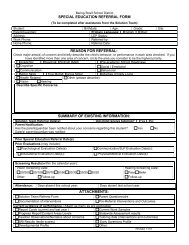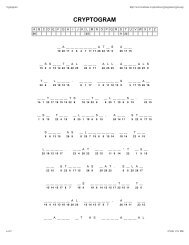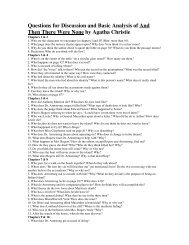Download “Eric Carle Mural” (PDF, 1387 kB) - Project ARTiculate
Download “Eric Carle Mural” (PDF, 1387 kB) - Project ARTiculate
Download “Eric Carle Mural” (PDF, 1387 kB) - Project ARTiculate
You also want an ePaper? Increase the reach of your titles
YUMPU automatically turns print PDFs into web optimized ePapers that Google loves.
Fairbanks North Star Borough School District<br />
Art Center Art Activity Kit©<br />
Eric <strong>Carle</strong> Mural<br />
GRADE: 1<br />
TIME: 1 Session<br />
Developed by Jenifer Cameron and Karen Stomberg<br />
KIT INCLUDES:<br />
• lesson plan<br />
• book Where Are You<br />
Going? To See My Friend<br />
• lesson example<br />
• process board (2)<br />
• texture example board<br />
• character sounds board<br />
• character puppets (5)<br />
•vocabulary boards (2)<br />
MATERIALS:<br />
construction paper:<br />
•various colors cut into<br />
4”x 6” rectangles<br />
butcher paper (roll type)<br />
•6 feet long, white or<br />
light color<br />
crayons<br />
•short, old ones for<br />
rubbing<br />
glue stick<br />
pencil<br />
LESSON DESCRIPTION:<br />
After sharing the book Where are<br />
You Going? To See my Friend,<br />
students discuss real and abstract<br />
artwork. They will learn how to use<br />
texture rubbings to create torn paper<br />
animals and people. Students then<br />
assemble a collaborative work of art<br />
displaying characters from the book.<br />
VOCABULARY:<br />
texture abstract<br />
shape realistic<br />
oval collage<br />
square mural<br />
rectangle circle<br />
ART ELEMENTS:<br />
Line<br />
x Shape/Form<br />
Color<br />
Value<br />
x Texture<br />
Space/Perspective<br />
ART PRINCIPLES:<br />
Pattern<br />
Rhythm/movement<br />
Proportion/Scale<br />
Balance<br />
Unity<br />
Emphasis<br />
CONTENT<br />
CONNECTIONS:<br />
Social Studies<br />
Multi-cultural<br />
THEMES:<br />
Friends<br />
OBJECTIVES AND ASSESSMENT CRITERIA:<br />
..<br />
. 1. Students will be able to know the difference between abstract and realistic art.<br />
2. Students will learn how to rub different textures onto paper.<br />
3. Students will compare English style writing and Japanese style writing.<br />
4. Students will learn how to tear a shape from paper.<br />
PREPARE:<br />
•Cut construction paper into rectangles (all colors).<br />
•Have old crayons available.<br />
•Hang butcher paper horizontally on wall at student level.
ENGAGE AND EXPLORE:<br />
Eric <strong>Carle</strong> and Kazuo Iwamura created a wonderful story about being friends, even<br />
though they lived in different countries half way around the world from each other. This<br />
book was a collaboration between the two authors and artists, both demonstrating their<br />
unique styles and cultural influences to create this story about friends. Eric <strong>Carle</strong> uses a<br />
technique called collage. Eric <strong>Carle</strong> begins his artwork by first painting on thin tissue<br />
paper. He then cuts out his shapes and glues them down on heavier paper. His artwork<br />
is best described as abstract. His designs are usually very colorful and have a lot of<br />
patterning and texture. Kazuo Iwamura works with a more traditional style, using realistic<br />
paintings of animals and people in his artwork. Whether you like abstract or realistic<br />
styles of art, you will have fun comparing and enjoying these two artists and authors<br />
work.<br />
Before beginning lesson, display the vocabulary boards.<br />
1. Gather students together to share the book, Where Are You Going? To See My<br />
Friend! Pass out the puppets to students. They can be grouped or partnered. Read the<br />
first half of the book. Have students respond with the voice of their character, i.e.,<br />
(Meow, Meow, Meow) when their part is read. Engage the students in prediction<br />
strategies (Who do you think their friend is?) Also, discuss with the students the collage<br />
technique and the abstract forms of the animals. Point out how Eric <strong>Carle</strong> has created<br />
his animals using shapes. Look closely at the different textures on the animals. Some<br />
textures look like fur, some like feathers.<br />
2. Stop reading the story just before the fold out pages. Explain to the students that this<br />
book was written and illustrated by two people. Flip the book to the back and explain that<br />
Kazuo Iwamura is from Japan, and the Japanese language is written top to bottom and is<br />
read from the right to the left, back to front. Unless you can read Japanese, have the<br />
students “read” the story using the pictures as clues. It is the same story as the English<br />
portion. Discuss the differences in the artwork. Kazuo Iwamura uses a realistic style to<br />
create his artwork. The animals look much more real and are painted rather than<br />
collaged.<br />
3. Stop reading the story just before the fold out pages. Ask students to predict what<br />
they think is on the fold out pages. Unfold the pages and introduce the students to the<br />
word mural. A mural is large piece of artwork that is usually horizontal. Sing the song<br />
together and enjoy the illustrations, comparing the abstract and realistic animals and<br />
people. Collect the puppets.
CREATE:<br />
Display the lesson process boards where students can view them easily.<br />
Have students remain in the circle area as you demonstrate the lesson. Explain that they<br />
will be creating an abstract animal in the style of Eric <strong>Carle</strong>. They will be rubbing<br />
textures with a crayon onto construction paper and then tearing shapes and gluing them<br />
together to create the animals.<br />
1. Demonstrate with a piece of construction paper and a crayon how to rub a texture.<br />
Use a texture board from the kit, or a found texture from something in the room. The<br />
bottom of a shoe works great, or the carpet, or heater vents. Whatever you can “find”.<br />
Show students how to use the side of the crayon to get a good rubbing. (Using the point<br />
of the crayon doesn’t work as well.)<br />
2. After you have rubbed three different textures, demonstrate for students how you can<br />
tear a shape from the paper. Show them how to fold the paper in half, then with<br />
their fingertip and thumb, pinch the paper and make small, tiny tears. Tear an oval<br />
from a paper that is folded the thin way, (or the hot dog way) and a circle from a paper<br />
folded the wide way, (or the hamburger way). Put these two together to create the body<br />
of an animal. Next, tear the legs, tail, and ears from the other papers. (Point to the<br />
process board as you demonstrate the technique.) Students may also choose to make a<br />
person or insect. Use the book for examples and ideas.<br />
3. When finished with tearing the parts of the animals, glue the parts together using a<br />
glue stick. Rub small paper pieces across the top of the glue stick. If using white glue,<br />
remind students to just use a small “dot” of glue. Apply the glue only where the two<br />
pieces will join together.<br />
4. Students can tear the eyes, nose and mouth as well, or they can just draw them on.<br />
Have students sign their name to the back of their character with a pencil.<br />
5. When finished with their character, have students bring them up to the horizontal<br />
butcher paper at the front of the room and glue them on. Have them put the glue on the<br />
side with their name.<br />
6. Glue on the title pages to both ends of the mural. (Make copies of the title from the<br />
master included in the lesson plan)<br />
Where<br />
are<br />
You<br />
Going?<br />
To See<br />
My<br />
Friend!
CLOSE:<br />
Have students clean up paper scraps. Save scraps and put in an art center so students can<br />
continue to explore creating characters with the collage technique.<br />
This is a collaborative work of art but individual artwork can be taken off the mural when display is<br />
ready to be taken down.<br />
Students can create a graph about the mural (insects, cats, dogs etc.) Students can also act out<br />
the story as a play. Having the students write a story about a friend, or writing to Eric <strong>Carle</strong> can<br />
create a literature connection.<br />
ASSESSMENT:<br />
Teacher administered assessment tool<br />
DN<br />
.<br />
OK<br />
UP<br />
Lesson___________________ Teacher______________________________<br />
Grade___________Date_____________Number of Students_______________<br />
Using the thumbs up, ok, and down technique, ask your students<br />
the following questions and record their answers.<br />
(K=knowledge, S=skills, C= creativity, A=attitude, E=engagement<br />
1. Can you recognize the difference between abstract and realistic art styles?<br />
2. Did you create three different textures?<br />
3. Were you able to tear a circle, oval or rectangle shape from your paper?<br />
4. Did you add an imaginative touch to your art?<br />
5. Did you actively listen and follow directions?<br />
6. Did you do your best during the lesson?<br />
7. Can you read Japanese?<br />
Teacher self-critique<br />
8. My teaching of this lesson:<br />
1 2 3 4 5 6 7 8 9 10<br />
needed improvement<br />
was highly successful<br />
9. What would I do differently next time?<br />
Alignment of Standards:<br />
ALIGNMENT:<br />
Art A 1,4,57 B 6,7,8 C 4,5 D 6,7<br />
Geography B,E<br />
World Language B<br />
Cultural C,D,E<br />
CREDITS:<br />
<strong>Project</strong> <strong>ARTiculate</strong> is supported by the Fairbanks North Star Borough School District, the Alaska Arts<br />
Education Consortium, and a U.S. Department of Education<br />
Development and Dissemination Grant
















